

Damion Smy
Boxy new KGM Musso unveiled to take on HiLux and Ranger ahead of Australian launch
13 Hours Ago
This hydrogen car emits only water and air, can drive around 650km on a tank, and is filled up in five minutes. Toyota thinks fuel-cell EVs have a big future in its range

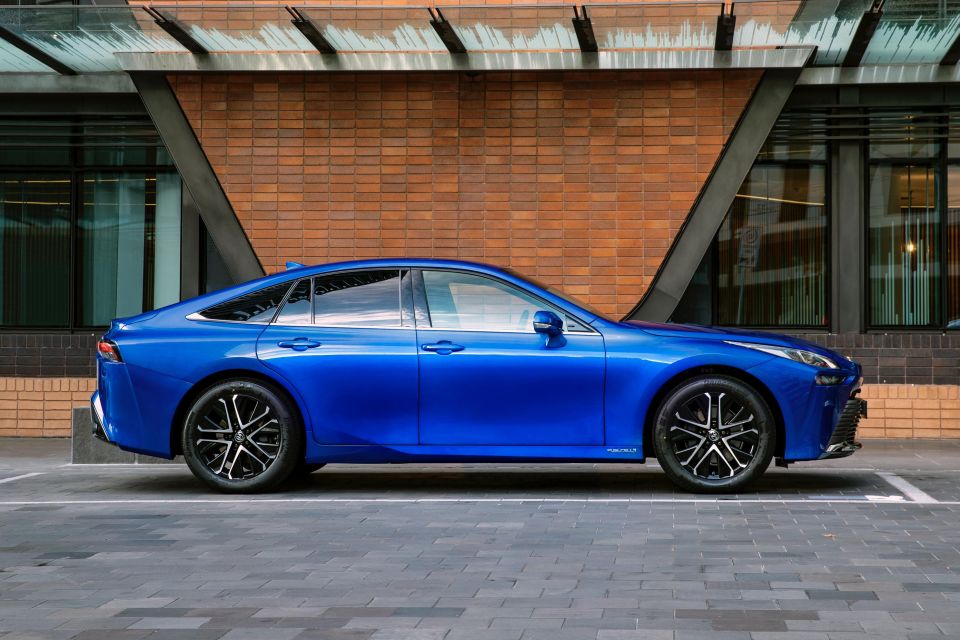

Senior Contributor

Senior Contributor


Senior Contributor

Senior Contributor
Quickly see how this car stacks up against its competition. Select any benchmark to see more details.
Where expert car reviews meet expert car buying – CarExpert gives you trusted advice, personalised service and real savings on your next new car.
Toyota is the second carmaker in Australia to get full design-rule approval and seek fleet customers for a fuel-cell electric vehicle (FCEV) powered by hydrogen, after Hyundai.
There are currently 20 second-generation Mirai sedans in the country to be allocated to corporate fleets and government partners, as the company seeks to make this a viable alternative to battery-electric vehicles (BEVs). It’s a followup to smaller trials with the old Mirai.
This is also the same number of Hyundai Nexos imported and allocated to the ACT government’s public servant fleet a few weeks ago.
MORE: 2021 Hyundai Nexo review

Despite the modest start, the ultimate goal is mainstream FCEV sales alongside Toyota’s existing range of hybrid cars and planned rollout of BEVs as soon as 2022, starting with a RAV4-sized model built on a ground-up architecture called bZ4X.
Hydrogen is the most abundant element in the universe, and can be made and stored in commercial quantities using renewable energy, though it can also be made through fossil fuels. When this hydrogen meets oxygen in a car’s fuel-cell heart, a chemical reaction creates charge to drive motors with no local CO2 emissions, just like a battery electric vehicle (BEV).
For various good reasons FCEV has long been considered by many to be an inferior technology for regular cars, a wasteful detour that’s hard to commercialise. Pressurised hydrogen is expensive when green, and losses under electrolysis from wire to gas to wire are evident.
FCEV tech has instead widely been seen as more suited to trucks, buses and ships that can run off a centralised refiller depot, need a long range and rapid refills, and which require the higher payload potential that comes from removing all those BEV batteries.
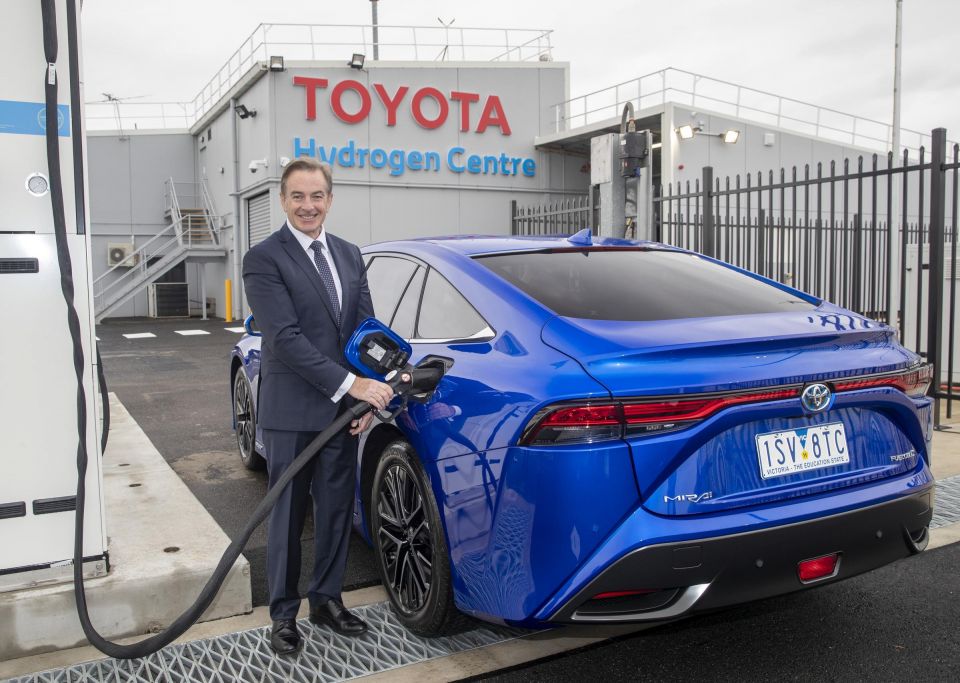
Companies including Tesla and Volkswagen are in fact highly critical of hydrogen cars, and view it as an inefficient BEV distraction at best. BloombergNEF concluded that: “the bulk of the car, bus and light-truck market looks set to adopt [battery electric technology], which are a cheaper solution than fuel cells”.
But Toyota sees a future for FCEVs and BEVs alike, and wants the market to decide. “We cannot achieve carbon neutrality by simply turning all our cars into battery electric vehicles,” reckons Toyota Australia’s vice-president of sales and marketing Sean Hanley.
Toyota Australia in fact believes hydrogen FCEVs like this will be “readily available” in dealers to the general public within two to three years, and suggests the path to widespread acceptance will be far quicker than the 20 years it took Australia fully embrace hybrid cars.
To support the new Mirai, Toyota has also built a permanent hydrogen fuel station at its western Melbourne Centre of Excellence, which uses solar panels (and the grid for backup) to power an electrolyser that isolates hydrogen from water via a charged current.
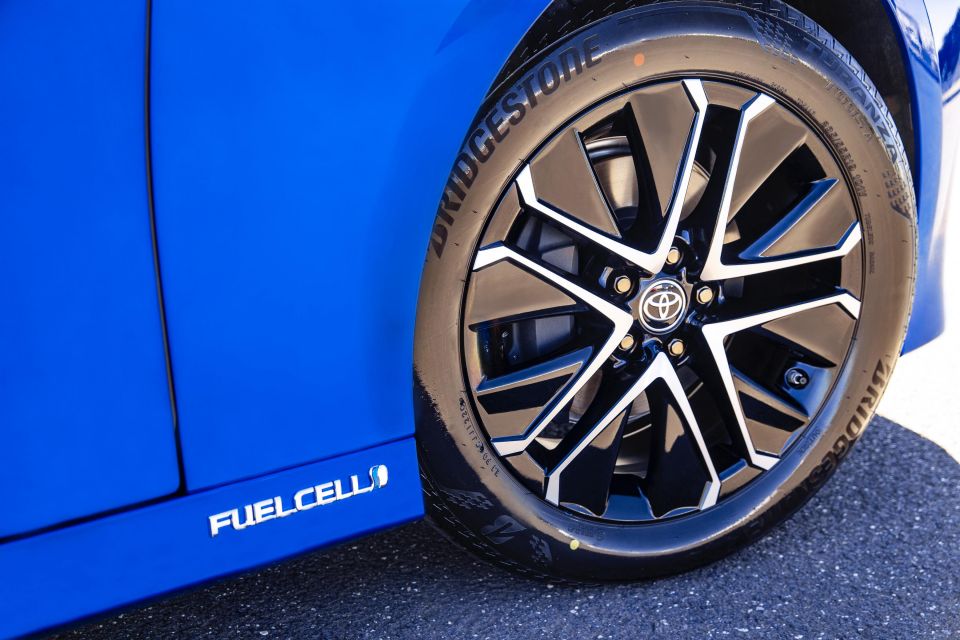
One also must recognise Australia’s governments and big corporations like Fortescue are pivoting to make hydrogen energy storage and production a major part of their agendas, in a bid to decarbonise industry and grow a new Asian export sector. This opens up rather obvious opportunities.
With all this in mind, have we underestimated FCEV tech? Or is the Mirai just an expensive rolling advertisement designed to get people talking?
I tend to think the answer to both of these questions is yes. And frankly that’s quite okay. What comes next is still anyone’s guess.
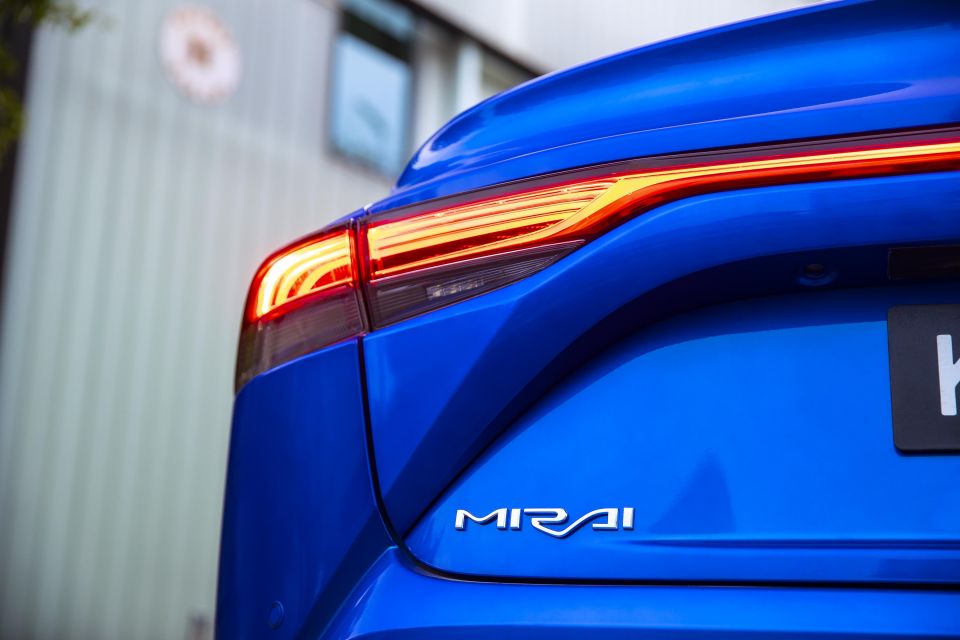
The Mirai lease program will cost $1750 per month on a three-year and 60,000km contract including the cost of hydrogen supplied from Toyota’s new refiller at its Altona Centre of Excellence in Melbourne’s west.
That’s a grand total for three years of $63,000, plus a further $2700 to cover servicing over the lease period.
Toyota has chosen to publish the cost of its Mirai lease program, unlike Hyundai.
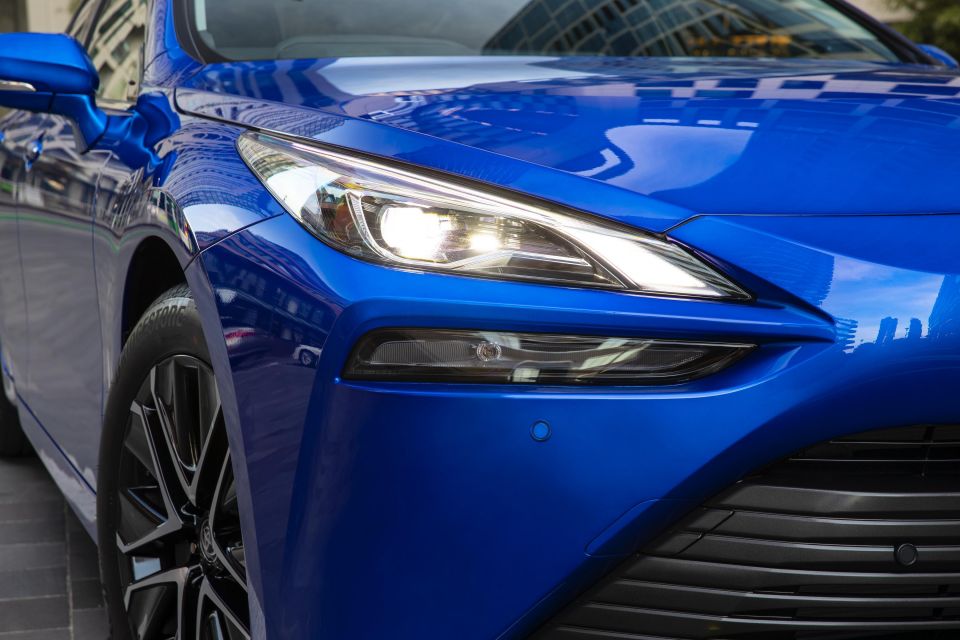
Buy your new car without the stress. It's fast, simple and completely free.

Great service from Travis and team, second time I have used this business would not hesitate to recommend them to anyone
Craig C.
Purchased a Ford Ranger in Sunshine Coast, QLD
CarExpert helped Craig save thousands on his Ford Ranger, now let us save you on your next new car.
Find a dealThe new Mirai measures 4975mm long, 1885mm wide, 1470mm tall, and sits on a 2920mm wheelbase. That’s 70mm longer and 45mm wider than a Camry.
Exterior
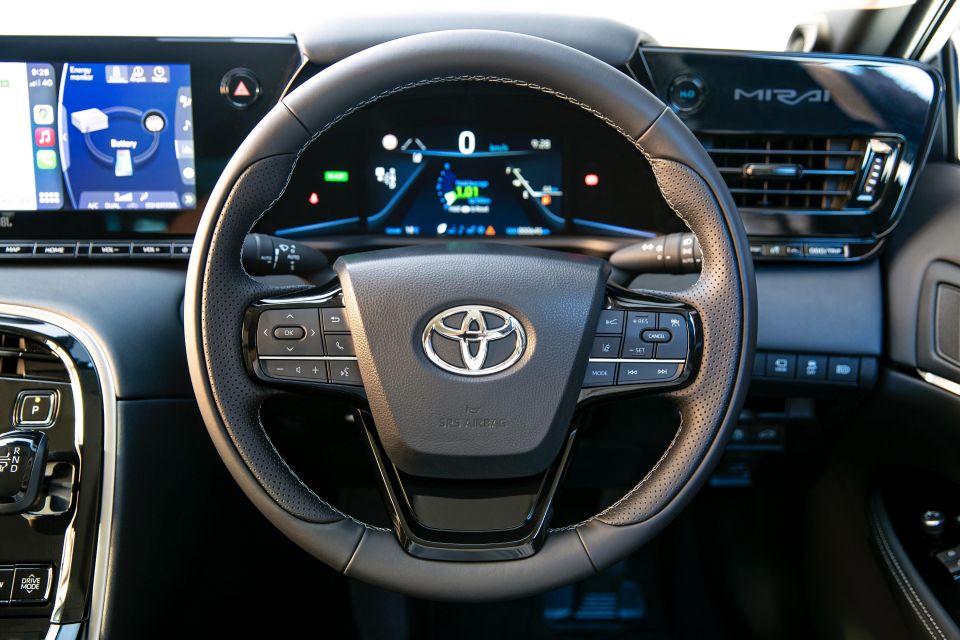
Interior
Seven exterior are available colours: Arctic White, Tarmac Black, Liquid Metal, Feverish Red, Force Blue, Silver Rush and Dynamic Blue.
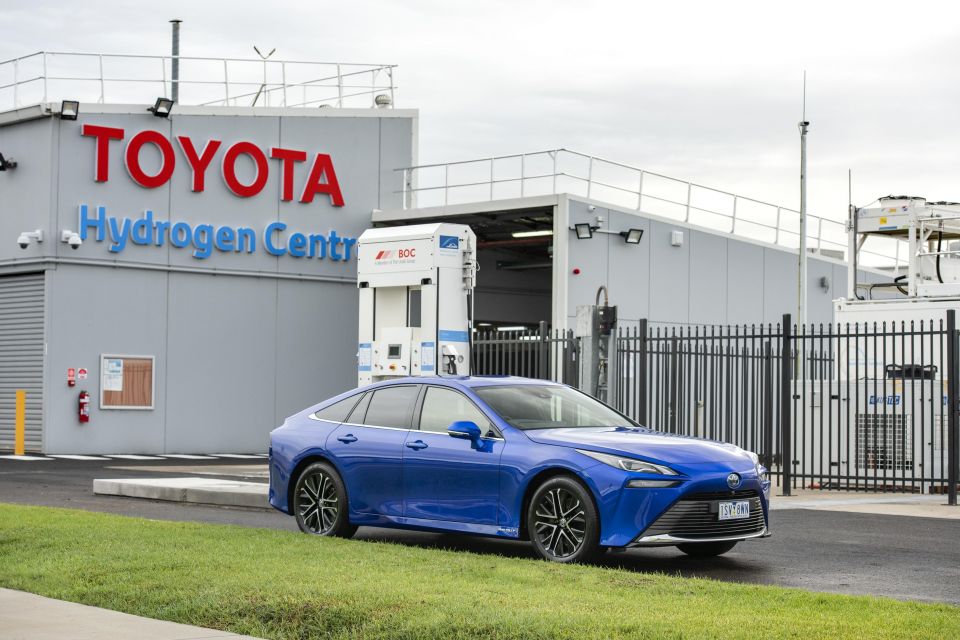
The 2021 Toyota Mirai hasn’t been crash tested by Euro NCAP or ANCAP. For background the hydrogen tanks are wrapped in carbon-fibre reinforced plastic and are designed to withstand typical crashes. The Hyundai Nexo has a maximum five-star crash score.
Atop seven airbags and ISOFIX or top-tether child seat anchors, standard safety features include:
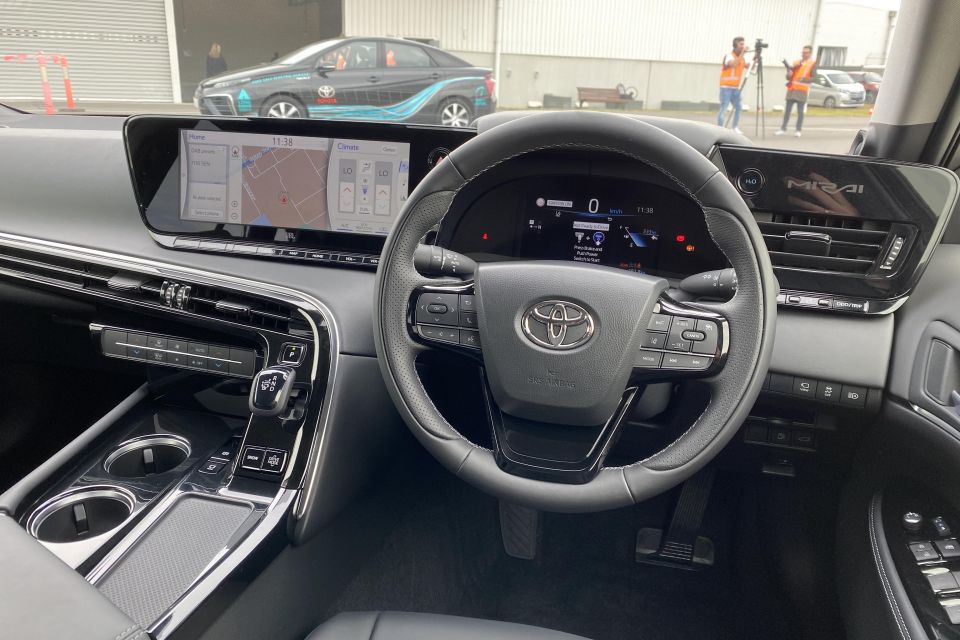
Nicer than any other Toyota sedan I’ve driven. Then again, it’s also far more expensive… Key touch points finished in nice real or synthetic leather-like materials, and the build quality felt impeccable.
Large digital instruments sit behind the perforated leather-wrapped wheel, to the right of which sits a H2O dump button. The large centre touchscreen is tilted towards the driver and displays a more intuitive and swish infotainment system than most Toyotas I’ve sampled lately.
You can view two screens at once, so I tended to have maps running in the left-hand portion and watched some cool live-action diagrams describing the fuel-cell system’s inner workings on the other section.
Below this sits a welcome series of ventilation hard buttons and full-width horizontally-aligned vents. The gear stick (by wire) is a stubby little unit with a P-for Park button, and two buttons to control the driving modes (throttle calibration etc) below.
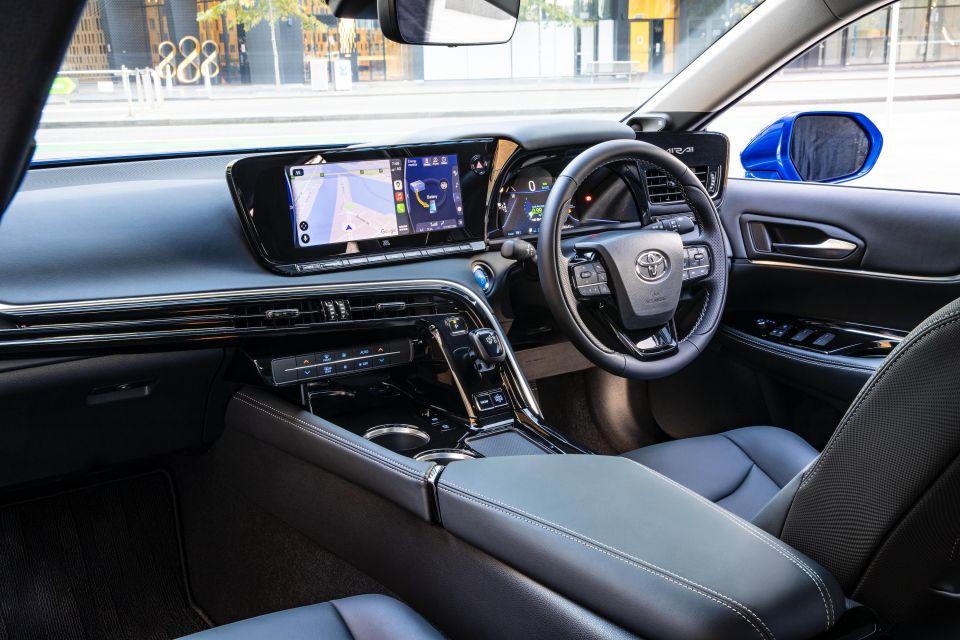
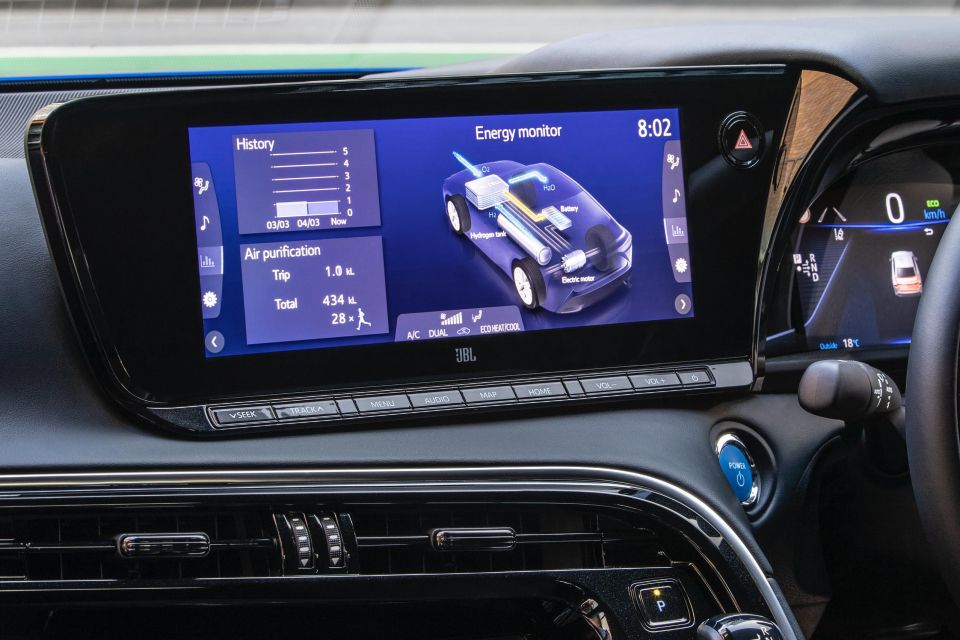
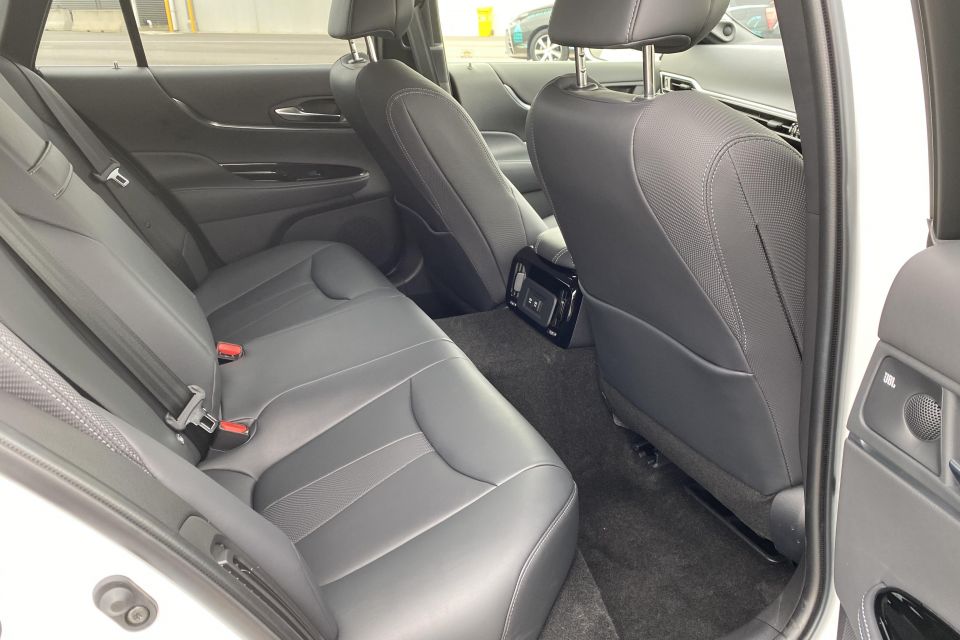

There’s plenty of storage in the doors and along the tunnel.
The back seats can comfortably accommodate two adults of 190cm or below, though toe room felt tight. The large driveline hump where the centre longitudinal tank is stowed renders the fifth seat largely useless, and demonstrates the packaging challenges against a flat-floor ground-up BEV.
One downside of having three hydrogen tanks and a drive unit at the rear between independent (multi-link) suspension is the subsequently small boot measuring 272 litres, or about half what a Camry stows.
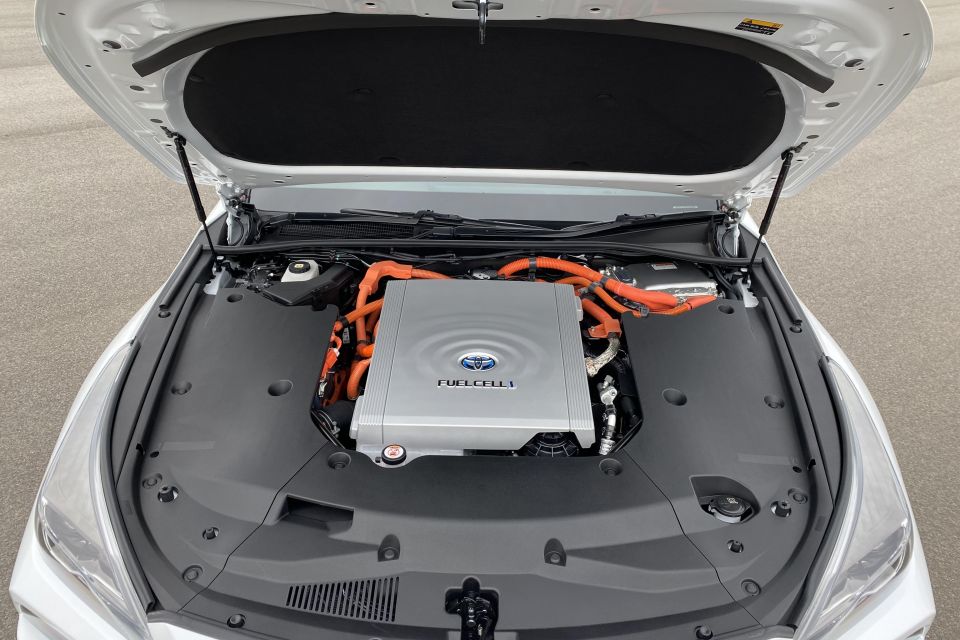
Broadly speaking, hydrogen FCEVs like these store pressurised hydrogen in chassis-mounted tanks and mix it with oxygen in a stack of membranes. The chemical reaction makes charge to spin the motor, and emits clean water and purified air as byproducts.
The Mirai’s chassis houses three carbon-fibre reinforced-plastic hydrogen storage tanks: two mounted transverse and one longitudinally down the centre tunnel. The storage potential is 141 litres or 5.6kg of hydrogen pressured to 700 bar.
The other components include a solid polymer electrolyte fuel-cell stack with 330 cells mounted under the bonnet alongside the air intake, compressor, electricity converter, cooling system, and power control unit.
Electricity created by the reaction between the hydrogen and atmospheric oxygen in the fuel-cell drives the motor, but reserves can also be fed into a hybrid-sized 1.2kW lithium-ion battery mounted behind the back seats.
Unlike the first-generation Mirai, this new one is rear-wheel drive.
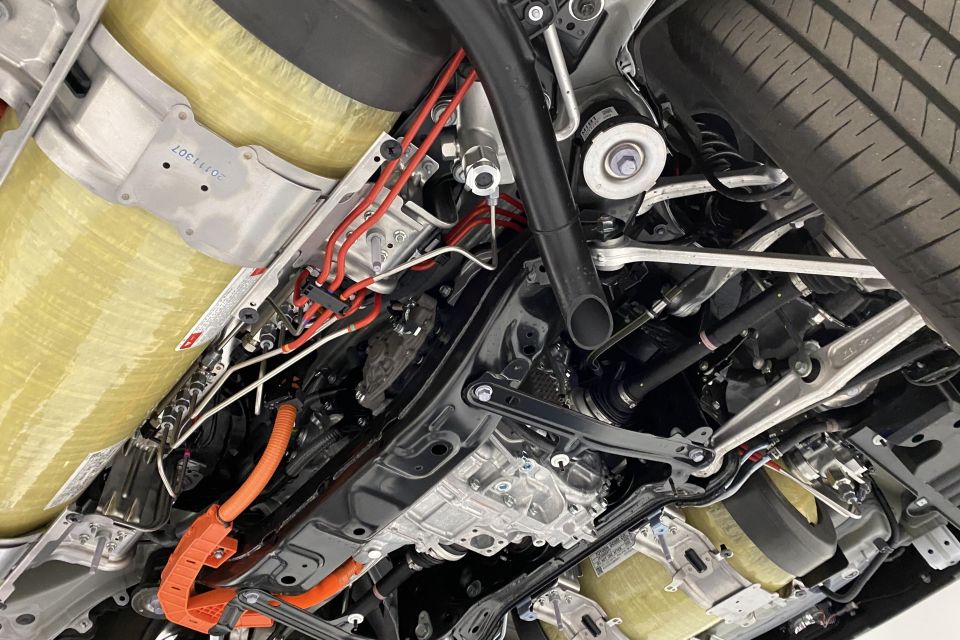
The motor mounted in the rear transaxle (alongside a single-speed direct-drive transmission and differential) produces 134kW of peak power and 300Nm of peak torque.
The claimed 0-100km/h dash time is 9.2 seconds and the top speed 175km/h.
For some context, the almost Camry-sized Mirai weighs about 350kg more (1900kg kerb), and produces the same engine power as a four-cylinder version but 65Nm more torque.
The Mirai can travel up to 650km (WLTP) using 141 litres or 5.6kg of H2. This means fuel economy of 0.7kg per 100km. In a typical hydrogen fuel cell, each kg of fuel produces 9kg of water.
Each refill takes about five minutes.
Public refill sites right now include one in Canberra linked to a wind farm, and Toyota’s own solar-powered site in Melbourne. The CSIRO is working on one for Melbourne’s east, and there are projects underway across all states and territories bar the Northern Territory as of this moment.
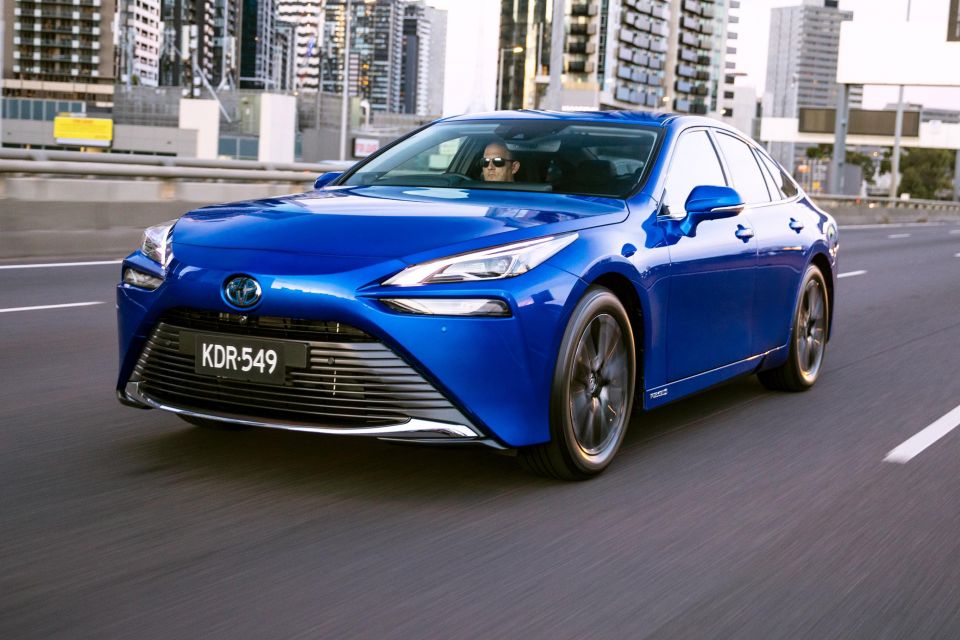
“We took all the customer feedback to heart and redesigned and reengineered the Mirai from the ground up, with the goal of creating a vehicle people would be excited to buy,” said chief engineer Yoshikazu Tanaka.
“We have worked to make a car that customers will want to drive all the time, a car that has an emotional and attractive design and the kind of dynamic and responsive performance that can bring a smile to the driverʼs face.
“I want customers to say, ‘I chose the Mirai because I simply wanted this car, and it just happens to be an FCEV.”

Where expert car reviews meet expert car buying – CarExpert gives you trusted advice, personalised service and real savings on your next new car.
With this in in mind, how does it drive? Very much like a BEV, since it runs thanks to electric motors. FCEVs are EVs, after all. The real difference is that it makes its own power rather than solely using stored energy from a battery.
It’s not rapid, but keeps up with traffic well enough. Like all electric cars it runs largely silently (especially compared to the old Mirai, which had a much more audible FCEV system) and offers instantaneous throttle response due to all that immediate torque.
The idea of being able to fill up in a few minutes is certainly appealing, because even the most rapid road-going 350kW DC charge-able and 800V-capable BEVs can’t quite match that yet.
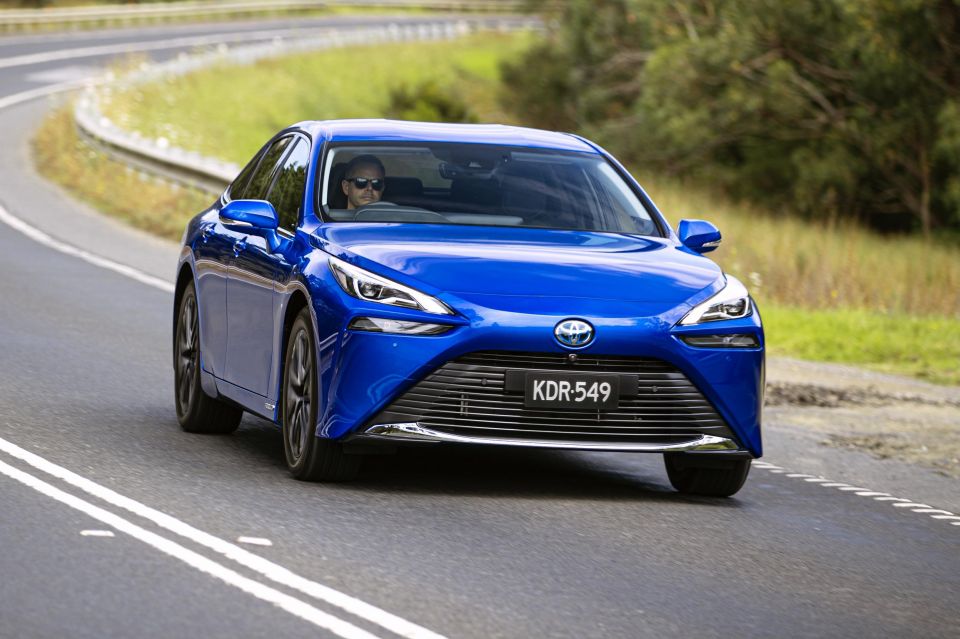
The familiar Toyota New Generation Architecture (TNGA) platform and “highly rigid body structure” pay dividends, making this rear-wheel drive sedan drive nearly as crisply as its design suggests.
The Mirai uses high-mounted front and low-mounted rear multi-link suspension with die-cast aluminium front suspension towers. The electrically-assisted rack and pinion steering system delivers acceptable (not totally remote) feel and feedback, and has a 2.5 turns lock-to-lock radius.
Brakes are bigger-than-average 334mm ventilated discs with four-piston calipers on the front and 335mm ventilated discs with two-piston calipers on the rear. The brake-energy recuperation feel is quite absent, though.
Against the clunky old Mirai, this new one rides and handles like a luxury sedan should.
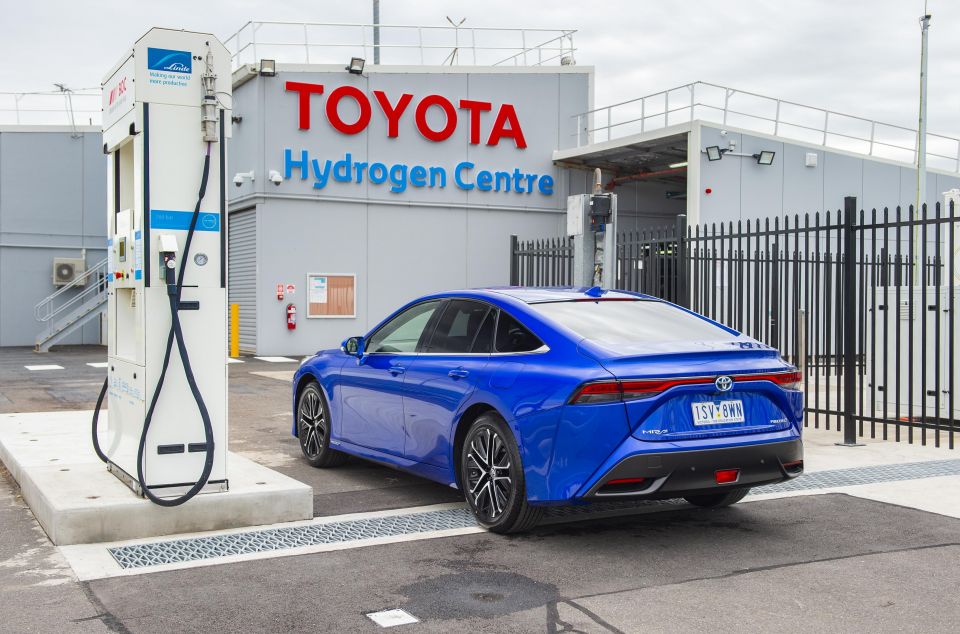
The monthly lease plan includes fuel from Toyota’s Altona refiller. The federal government has stated its mid-term goal of getting the wholesale price of hydrogen down to $2 per kilogram, which means even then it would cost more to refill a Mirai than charge a BEV such as the Tesla Model 3 on off-peak power.
Upfront costs for all servicing over the three-year lease are $2700, equal to $900 per annum.
Toyota needs to get its dealers trained in servicing FCEVs, but initial lease partners will need to return their Mirais to the company’s HQ.
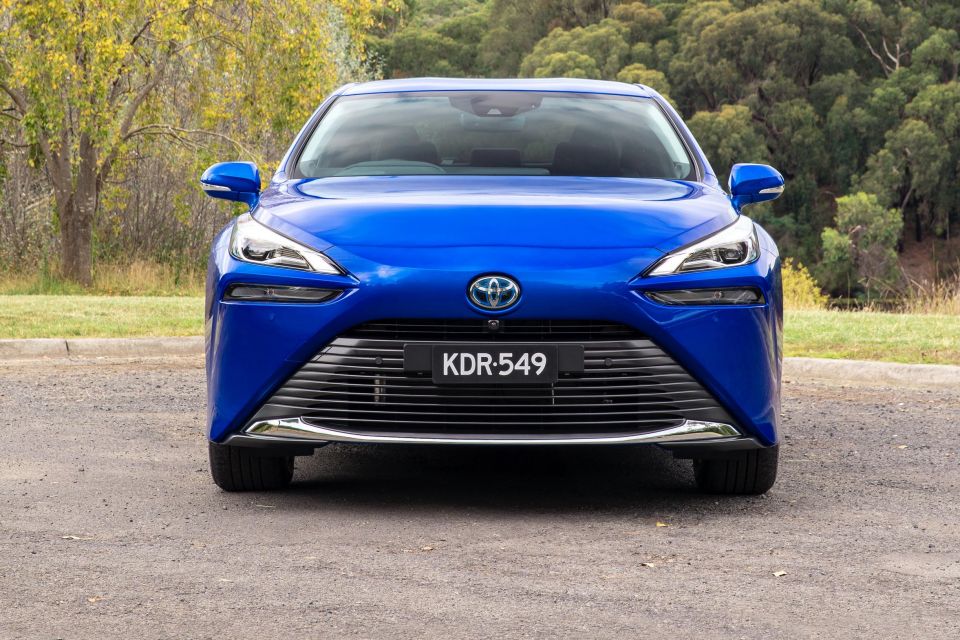
The cost of hydrogen fuel-cells, which use a comparatively low proportion of precious and expensive materials, has inherent scope to become drastically cheaper pending commercialisation and production scale.
If we can get to the point where Australia has a thriving network of green hydrogen fillers, and FCEVs become vaguely affordable, then they’ll likely proliferate since their usability to some sectors should outweigh the filling costs.
FCEVs aren’t the enemy of BEVs. Both vehicle types are only really as green as their power sources. Of course right now the Mirai remains a largely unviable commercial proposition, but if Toyota wants to keep honing its approach then we should be open to it.
It’s hard to imagine owning a FCEV before an EV, but if it’s low-emissions and works for some sectors, then we should pay attention. The Mirai and Nexo have helped demonstrate the efficacy of the technology.
MORE: Toyota showroom and data pages MORE: All CarExpert hydrogen FCEV-related stories MORE: Filling it up – Hydrogen MORE: Hyundai’s hydrogen fuel-cell trucks in Australia as soon as 2025 MORE: Ineos and Hyundai teaming up on hydrogen MORE: Plans afoot to make hydrogen electrolysers and fuelers in Australia
Where expert car reviews meet expert car buying – CarExpert gives you trusted advice, personalised service and real savings on your next new car.


Damion Smy
13 Hours Ago


Damion Smy
15 Hours Ago


Damion Smy
16 Hours Ago


Damion Smy
18 Hours Ago


Damion Smy
19 Hours Ago


Damion Smy
21 Hours Ago